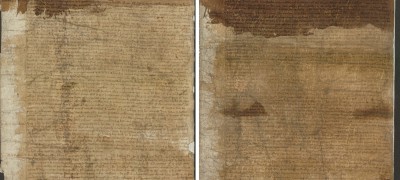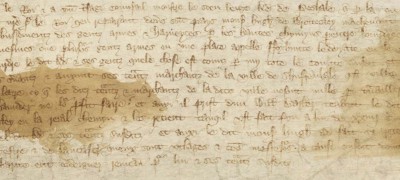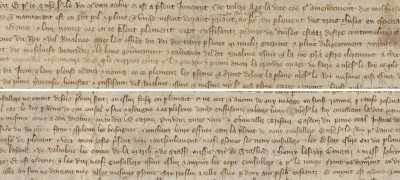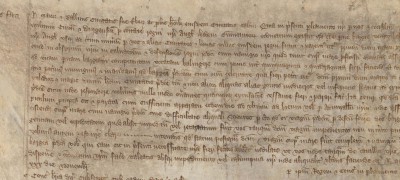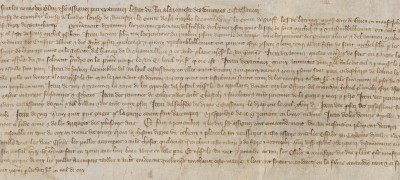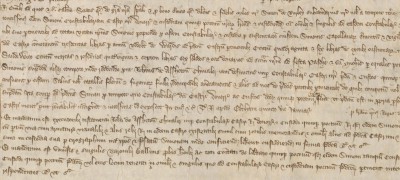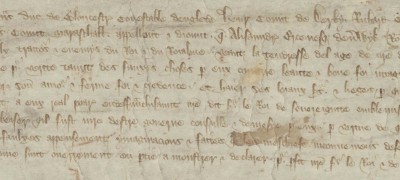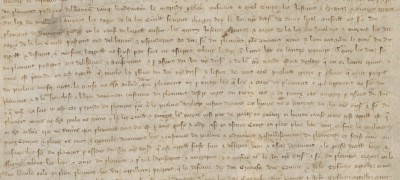
Download documents and transcripts
Teachers' notes
This lesson is structured into two parts with a prompt question and explores original documents which support an enquiry into the reign of Richard II 1377-1399 and places emphasis on his minority, personal rule and overthrow.
Part 1: The coronation of Richard II
Here students study two sources which relate to the importance of the coronation ceremony in late-medieval England and what it reveals about the power of medieval kingship. The sources provide an opening context for the reign of Richard II. The first record provides insight into the nature and role of medieval coronation and highlights how powerful people tried to extend their control by establishing their right to take part in the ceremony. The second document outlines the personal experience of one individual who attended.
Part 2: Enquiry question: To what extent were the troubles facing England in the 1370s and 1380s the result of Richard II’s youthfulness?
Here the students study six sources to explore this enquiry question. The documents cover the following topics: the appointment and role of the ‘continual council’ in view of the age of the king in document 3, the development of shipbuilding programme in document 4 and an investigation into the king’s personal expenses which again raises issues of royal power and the youthfulness of the king in document 5. Document 6 shows how the king tried to act independently from the council. The Merciless Parliament, formed in rebellion against Richard II, is evidenced with document 7.
Finally, document 8 highlights the Lords Appellant’s justification for their rebellion, throwing into sharp relief the position of the king in the political power structure.
When working with these original documents students should consider if the sources share the same ideas, attitudes and arguments and if they can explain any differences between them.
The records used include ancient petitions, extracts from Parliament rolls and royal grants. We hope that they will offer students a chance to develop their powers of evaluation and analysis. All sources have been provided with a transcript and, as the language may prove challenging, we have also provided a simplified version with more difficult words defined within the text. Each source is captioned to provide a sense of what the document is about. Teachers may want to break their class up into groups and get students to feed back on the different sets of documents and/or annotate them at the whiteboard. Alternatively, teachers may wish to use the sources to develop their own lesson in a different way or combine with other sources available on our Magna Carta website or within our Magna Carta document collection – Magna Carta, 1215 and beyond – as part of a medieval study.
Key stage 5
OCR A level History: Enquiry topic unit Y104: Richard II 1377-1399. Key topics: Richard’s minority, Personal rule, Personal rule and overthrow.
Key stage 4
AQA GCSE History (8145)
Thematic study 2B Britain: Power and the People c1170 to the present day,
OCR GCSE
History A: Explaining the Modern World (J410). Unit: Monarchy and Democracy in Britain c1000 to 2014; challenges to power and power changing hands
Tasks
Explore a group of eight documents that relate to the reign of Richard II. The first two relate to his coronation ceremony and the others cover different aspects of his reign.
Part 1: The coronation of Richard II
- What do these two sources reveal about the importance of the coronation ceremony in late-medieval England?
Source 1: Proceedings at the King’s Coronation, 1377
Source 2: Attendance at Richard’s Coronation, 1377 - Why was the coronation ceremony significant in form and function for the king and those involved in the political structure?
Part 2: The reign of Richard II
- To what extent were the troubles facing England in the 1370s and 1380s the result of Richard II’s youthfulness? What do these six sources reveal?
Source 3: Appointment of the ‘continual council’, 1377
Source 4: Shipbuilding programme, 1377
Source 5: Inquiry into royal expenses, 1379
Source 6: Reward for service ‘in our tender age’, 1384
Source 7: The appeal of the Lords Appellant, 1388
Source 8: The importance and ‘legal supremacy’ of Parliament, 1388 - Did problems stem from Richard II’s age and inexperience?
- Is there evidence that any of the sources share similar ideas, attitudes or arguments? Can you explain any differences between them?
Introduction
When Richard II came to the English throne in 1377 he was only ten years old. For the foreseeable future, important political decisions would have to be made for him by the most powerful and experienced people in the kingdom. This included the organisation of his coronation, which was overseen by his uncle – John of Gaunt, Duke of Lancaster.
Richard II’s coronation took place at a time of great uncertainty and bloodshed. England had been at war with France intermittently since 1337 in the Hundred Years War. In June and July 1377 a French fleet attacked English ports all along the English Channel. Since the king could not be expected at such a young age to take leadership of the kingdom, the commons in Parliament requested that a special council be appointed to make key decisions and provide the king’s government with advice. The appointment of this ‘continual council’, along with a description of its responsibilities and powers, is recorded in documents here, as well as the decision taken by the continual council to improve England’s naval power by initiating a shipbuilding programme.
Despite these arrangements, the war with France continued to go badly. In the summer of 1381, peasants and craftsmen across the country rebelled against the government in the Peasants’ Revolt. The event was triggered by the high level of taxation needed to fund the war, and over the next few years the commons in Parliament put pressure on government to reduce its expenses. However, there was no easy solution to the conflict with France and the commons looked for other ways of saving money. Even before the Peasants’ Revolt they had sought to reduce government expenses. In 1379 the commons appointed a commission to investigate the financial health of the kingdom and how to reduce the cost of the royal household – in other words, the king’s personal expenses. This raises an important question: would Parliament have targeted the king’s personal expenditure if he had been older and exercised more direct control over the country? By 1384, Richard II wanted make his own decisions. For example, he granted his servant, Simon Burley, his under-chamberlain, a reward for the service he ‘did for us in our tender age’. At the age of 17, Richard II tried to exercise power and authority independently. The grant showed him rewarding those he felt close to, a tendency that became problematic during the next decade of his reign. The king began to lavishly reward his friends against the wishes of the broader political community.
A key theme of medieval kingship was ‘largesse’, a form of generosity. An effective king was expected to reward good service by showing generosity to his loyal subjects, typically by granting them land and titles. However, many people – especially members of the nobility – felt that Richard II was too generous to those who didn’t deserve it: people like his friend Robert de Vere, to whom he granted the whole of Ireland in 1385.
By 1386, a group of lords, known as the ‘Lords Appellant’, grew disillusioned with Richard II’s promotion of his favourites. They rebelled against the king, took him captive, and called a parliament known as the ‘Merciless Parliament’ to legitimise their rebellion and destroy many of the king’s friends, including Robert de Vere.
The Lords Appellant used Parliament as a weapon against their enemies, and brought the ‘traitors’ to trial before Parliament. They took care to justify the legality of their use of Parliament as a court of law by asserting that it was the only venue suitable to judge the ‘high crimes’ committed by their enemies. This justification was designed to mask the fact that the Lords Appellant were in rebellion against the king. Also, by bringing their enemies to trial in Parliament, the Lords Appellant were able to build consensus within the political community against the king and his friends.
External links
www.history.ac.uk/richardII/richardII.html
This website, produced by the Institute of Historical Research and Royal Holloway, provides background on the life of Richard II, portraits and dramatic interpretations of his reign.
www.westminster-abbey.org/our-history/royals/richard-ii-and-anne-of-bohemia
The most famous image of Richard II is held at Westminster Abbey and this link gives background on his burial.
